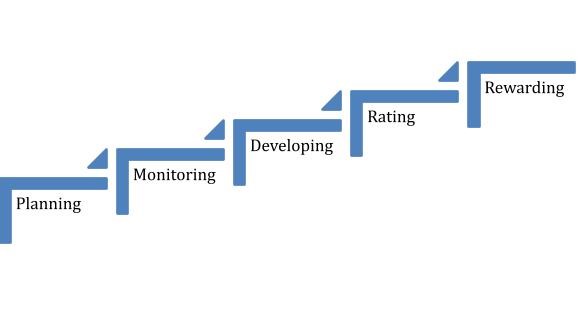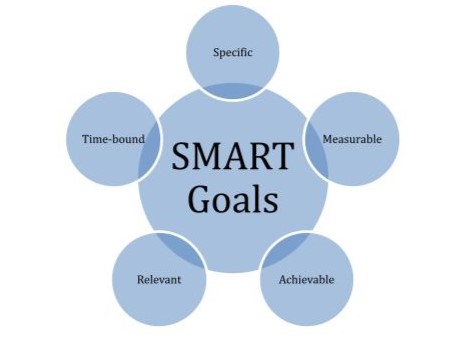In an organisation, all employees should be assigned goals that are distinct, attainable, and definable. Further, these goals are measured in terms of performance metrics and indicators that are relevant to each. Based on these, employees are mentored and provided feedback on how to perform better in their roles. This entire process falls under performance management – a key task taken up by most organisations.

According to a survey, 67% of employees believe that feedback from their managers is key to improving their performance. Another 61% believe that one-on-one sessions with their managers help improve their performance. Performance management is a key HR task that ensures all employees are performing up to the standard set for their role.
Let’s understand what makes managing performance for every employee a key task among businesses.
What is Performance Management?
Performance management is a strategic process taken up as an ongoing task. It provides an outline of tasks, roles, and responsibilities to each member of the staff and monitors performance based on set goals. Further, it aligns the goals set for employees to the organisational objectives, thus driving business success.
Every performance management process consists of the following key elements:
- Creating the performance management policy.
- Setting goals and expectations.
- Monitoring the progress of every employee.
- Conducting a periodic performance appraisal.
- Providing continuous feedback to workers.
- Laying out employee development plans.
- Rewarding the best performers.
Based on the above, the performance management process involves 4 key steps:
- Establishing clear expectations in terms of role and assignments.
- Setting individual goals that align with the ones for the team and the organisation.
- Providing continuous feedback to employees to guide and improve their performance.
- Evaluating the results obtained with the help of performance management and streamlining the process.
Thus, performance management is a strategic task geared at helping workers accomplish the strategic goals of the organisation. With an efficient performance management process, businesses can enjoy a 30% higher revenue growth.
Key Goals of the Performance Management Process
Performance management, irrespective of the organisation, serves two primary goals
- Evaluating the skills and competencies of every employee.
- Developing the skills and competencies that the employee needs to be effective in their role.
During the performance management process, goals are set for each employee, they are provided clarity regarding the tasks they have to achieve, and are provided with continuous feedback so that they can grow and improve.
Further, when deployed effectively, performance management does not stay limited to being an individual activity. Instead, it turns into a process that can help entire teams improve their performance and achieve the set performance targets. Studies state that organisations that take up the performance management process are 4.2 times more likely to outperform other businesses in their domain.
Why Managing Performance is Essential in Ensuring Organisational Success
According to a 2022 Betterworks study, 21% employees get annual targets. Further, almost 30% rarely receive regular feedback from their supervisors, and another 10% do not receive feedback at all. Thus, when it comes to practicing performance management, many organisations are falling short.
In practice, the performance management process helps an organisation with the following:
Future-Proofing Your Workforce’s Skills
Performance management helps workers identify where they are falling behind and improve through training, coaching, and mentoring. Further, it helps organisations build a skilled workforce who are ready to meet market demands.
Increased Employee Engagement
Proper performance management and feedback helps motivate employees through a system of recognition and reward. Further, it encourages workers to be productive and invested in their role as well as the success of the organisation.
Higher Employee Retention
With regular performance management, workers feel supported by the leadership, gaining security and guidance regarding their prospects in the organisation and the industry. Thus, it helps retain the top talent by offering them incentives and growth opportunities.
Fostering a Culture of Feedback and Trust
Efficient performance management systems offer a clear view of the performance of each employee in comparison to their peers. This helps businesses make an informed call regarding promotions, incentives, and others. Further, since open dialogue improves communication between the different levels (workers and managers), to establish expectations and offer honest feedback.
Improved Overall Organisational Performance
Through the feedback system established with the help of performance management, employees can receive regular feedback and guidance regarding how to perform better. A well-designed performance management system helps organisations meet their business goals, offering them a competitive edge, increasing their efficiency and profitability.
5 Key Stages of the Performance Management Cycle

A single performance management cycle can be divided into the following key stages:
Planning
This is associated with establishing the expectations associated with every job role. Not only are these outlined in the job description, but they should be reiterated to every employee. Further, performance plans need to be tailored to organisational objectives, with inputs taken from both employees and managers.
Monitoring
Based on the performance plans laid out for each employee, both managers and HRM need to regularly check the performance and work delivered by each employee. This routine evaluation highlights both one-time and recurrent issues, so that they are addressed on time. Further, it provides detailed information on every employee to be used during their performance meetings.
Developing
From the data obtained with routine performance monitoring, managers and HRM can identify which workers are doing well and which of them are falling behind. L&D programs, training courses, and seminars can be designed for employees who are falling behind and ones who are looking to develop their skills.
Rating
Along with creating L&D programs, employee monitoring data is also important for rating employees depending on their work and identifying the best performers. Further, it also helps recognise the workers who add the most value to the organisation.
Rewarding
Based on the performance rating that they have received, individual employees receive performance-based incentives, promotions, salary increments, and other rewards. This is further facilitated with a fair and transparent performance management system.
Performance Management Techniques and Methods That Work
Not all performance management methods are suitable for every organisation. Thus, the right performance management techniques should be chosen based on organisational requirements and their contribution to the employees and the business.
Some of the more popular methods for efficient and effective performance management include the following:
Goal Setting and Alignment

Businesses often use SMART* goals to provide employees with the much-needed clarity and motivation for their role. Further, the goals set can be sorted into performance, development, and stretch goals based on how they relate to the job role. Performance goals are the primary tasks associated with a given role. Development goals help identify the necessary skills for career progression. Stretch goals urge employees to go above and beyond their set role and build on their capabilities.
*SMART Goals refer to Specific, Measurable, Achievable, Relevant, and Time-bound goals.
Continuous Performance Management
A holistic approach, under the continuous performance management system, employee and their managers have several meetings throughout the year. During these, the managers can check in with employees, provide constructive feedback, and build a healthy working relationship. It also improves communication among the different levels of the organisation, fostering a culture of growth and development.
Management by Objectives (MBO)
This performance management system helps analyse the overall performance of a given employee placed in a certain role. It also helps set realistic goals and gain an understanding of what else an employee can do to bridge any skill gaps, whether existing or emerging. Further, it also helps understand the workload of the employees and identify if certain tasks need to be delegated.
360-Degree Feedback
Instead of accounting for inputs from just the managers, this method takes inputs from different levels of the organisation. Usually, this includes inputs from peers, supervisors, self-evaluations, and in certain cases, subordinates. Thus, it offers a broader view of each employee, not limited to just their deliverables.
Traditional and Modern Performance Appraisals
Appraisals are a periodic activity taken up annually or biannually. Here, the tasks delivered by the employee are accounted for to evaluate their performance. Performance appraisals serve as a space for identifying the strengths and weaknesses of a given employee, and chalking out a plan to help them improve. Further, it helps boost engagement, morale, and performance.
Coaching and Mentoring
Instead of simply laying out where an employee is falling short, managers can mentor their subordinates. This usually focuses on certain skills that the employee needs to perform well in a given role and progress to better roles, and is done through one-on-one sessions. However, to provide proper coaching and mentorship, the managers themselves should know how to mentor others.
Best Practices for an Effective Performance Management Process
A performance management cycle enjoys maximum efficacy when a manager or HRM employs the following best practices:
Evaluate What’s Working and What Isn’t
Every performance management process should be evaluated periodically on its effectiveness and the criteria covered. This helps root out what has become outdated in the industry as well as areas that have the most impact. These findings help fine-tune the performance management process, establishing a system that aligns with both industry and business needs.
Choose the Right Techniques
Performance management can either take a qualitative, behavioral approach (using non-quantifiable criteria such as communication and leadership skills) or a quantitative, result-oriented (using concrete criteria such as project completion and customer satisfaction) approach. The former helps map out the necessary behavioural traits in a person, while the latter uses result-oriented metrics to track performance. Businesses can use either or a meld of both, depending on the role in question.
Train Managers on Managing Performance
In order to manage the performance of employees, managers need to be trained in how to engage, motivate, and cultivate the workforce. Thus, L&D programs should not be limited to the employee but instead be expanded to accommodate the management, training them on how to mentor their workers.
Help Employees Set SMART Goals
Trackable, personalised KPIs (Key Performance Indicators) along with SMART Goals help employees understand the expectations and demands of their role. These can be further personalised for every employee, allowing timely feedback, effective goal-setting, and more accurate assessments.
Implement Continuous Feedback and Check-ins
Instead of limiting the system to periodic meetings and check-ins (as in the case of appraisals), a system of continuous feedback with regular mentorship sessions can be established. This helps managers get a more thorough view of their employees and offer them regular feedback.
Set Up a Formal Performance Management System
Not having a well-defined performance management system can lead to inconsistencies in how it is deployed or practiced across the organisation. Thus, all organisations need to have a formal, structured performance management process that boosts engagement, performance, and retention.
Support Employee Development Planning
Alongside performance management, managers and HRMs should also help employee plan their career progression. This involves employee development plans that empower workers to take responsibility for their career development and boost their skills.
Streamline the Performance Management Cycle with Technology
Instead of staying limited to a paper or spreadsheet-based system, businesses can benefit significantly from using software tools. In fact, 48% believe that using performance management software can significantly benefit the process, improving its efficiency.
Making Performance Management Work for Your Business
Managing performance of each and every employee is a routine task for any manager. However, instead of taking it up as necessary, a regular and uniform performance management process helps managers improve the performance of individual employees as well as entire teams. This, in turn, aids business success, increasing revenue and competitiveness.
Wish to enjoy the benefits of an effective performance management system? Employ suitable performance management techniques for your workers.





